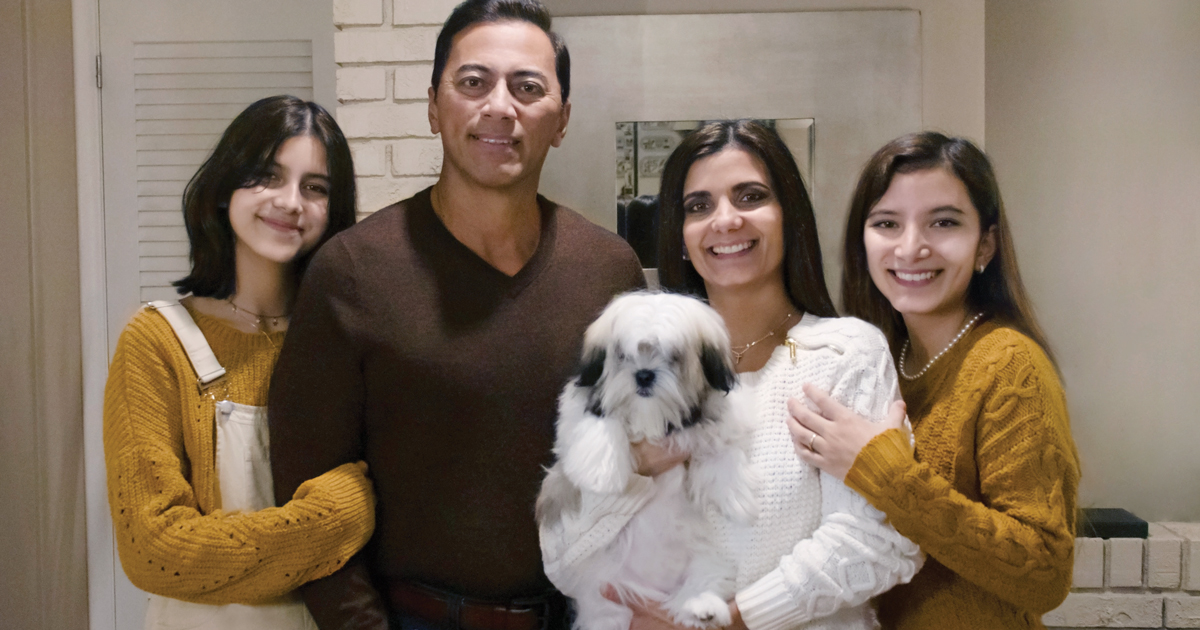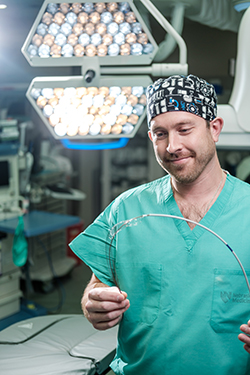A curious case of COVID blood clots, solved by a surgeon named Cook

When Veronica Calero caught COVID-19 in November 2020, she couldn't eat or drink for days.
"It was like someone knocked the wind out of me, 24/7," says Veronica. "I could not stop coughing, and my lungs hurt so bad." She'd try to force herself to move, but she could hardly walk.
Unfortunately, a January ultrasound showed a serious clot in her leg, called a deep vein thrombosis (DVT). The DVT was in addition to a blood clot that had traveled to her lungs – a pulmonary embolism (PE) found in December. Veronica's mother, Eleni, wrote to her physician, Iraklis Pipinos, MD, telling him of the situation.
Dr. Pipinos immediately referred Veronica to vascular surgeon Jason Cook, MD. The pair talked through everything together, which Veronica appreciated. She prepared detailed questions for him each time they'd speak. "You don't always get to speak to your surgeon because they're so busy," she says. "But Dr. Cook always listened and gave thorough answers."
"She's very organized and invested in her care," says Dr. Cook. "She held me accountable."
The curious case of the clot
At just 19 years old, Veronica is one of Dr. Cook's youngest DVT patients ever. Her family's history of clotting and her medication increased her risk of blood clots. A rare condition called May-Thurner syndrome put additional pressure on her left iliac vein, further increasing the chance of a clot forming.
Add all of these risk factors together, plus COVID-19? "Patients like Veronica would be more likely to develop a clot under normal conditions. Getting COVID-19, which results in a hypercoagulable state, can cause a significant DVT," explains Dr. Cook.
A newer procedure for DVTs

Veronica had two options: surgery or staying on blood thinners and wearing compression stockings, potentially for the rest of her life. The clot also raised the possibility of post-thrombotic syndrome (PTS), a condition marked by chronic pain and swelling.
"Often the standard of care is to place patients on a blood thinner to prevent new clots from forming," explains Dr. Cook. "But that doesn't actively remove the clot that's already formed. The longer the clot remains in the vein, the higher the risk for scarring of the vein and lifelong PTS."
"I realized this was serious," Veronica recalls. "It could have killed me."
Dr. Cook recommended a mechanical thrombectomy to remove the clot from her leg and reduce the risk of recurrent PE. The procedure uses a netlike bag, the Inari ClotTriever, to remove the clot from within a patient's veins. Dr. Cook inserts the bag above the clot, opens the bag and pulls it down through the clot. The clot is then removed, all in one surgery.
"The bag is open above the clot, which prevents debris from the clot from showering into the lungs," says Dr. Cook. "The bag can also remove the more chronic clotting, potentially preventing a second clot from forming in the future." Dr. Cook has been doing this newer procedure with the ClotTriever for four years.
The procedure requires patients to go into a twilight sleep, avoiding the risks of full sedation. Dr. Cook asked what kind of music Veronica wanted to hear while he operated.
"I take requests, as long as it's not Disney," he jokes.
The surgery went seamlessly. Another advantage of mechanical thrombectomy is the relatively short recovery. Compared to catheter-directed therapy, which requires two trips to the operating room and an ICU stay, mechanical thrombectomy is over in only one session. Veronica spent the night in the hospital after the procedure and was home the next day.
Clay, a sweet source of comfort
Nearly a year after getting COVID-19, Veronica still can't smell right. "I have phantom smells, where everything smells horrible." Things that used to smell sweet now give her the impression of wet dog. And citrus-type scents, like lemon, make her gag.
It may be a while before Veronica's smell returns to normal. But her veins are looking great, says Dr. Cook. "Everything has stayed open. She's had no new clots." Her lungs looked clear in the scan after the surgery, too.
A few months after surgery, the Calero-Anthis family welcomed home a new puppy: a Maltese Shih Tzu named Clay. Clay has been a huge source of comfort to Veronica. "He's helped me with everything that's been going on," she says. "It's been rough, but it's good to stay positive. There are brighter days ahead."
You can meet our doctors at NebraskaMed.com/Heart.







